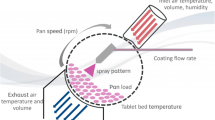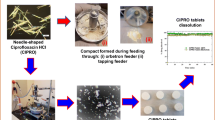Abstract
The purpose of this study was to determine the factors that influence fill weight and weight variability of capsules produced on the In-Cap and to assess any differences in terms of capsule defects between gelatin and HPMC (Quali-V) shells. The In-Cap is an automatic tamping type capsule-filling machine and the low output of ≈3000 capsules/hour makes it ideal for early formulation development and phase I/IIa clinical supplies manufacture. Four commonly used excipients (Avicel PH101, Avicel PH302, A-Tab, and Prosolv HD90) and a poorly flowing drug blend were encapsulated at various pin settings and powder bed heights. The average fill weight and coefficient of weight variation were determined. The percentage of defective capsules formed during encapsulation was calculated. Results of the study showed that pin setting was critical for controlling the fill weight and the weight variation. The order of pin setting with pin 1 (closer to the powder chute) set to a relatively higher position and pin 4 (before ejection) set to a lower position was found to give higher fill weights with relatively lower weight variability. The powder bed height influenced the fill weight for poorly flowing powders. The capsule machine speed did not appear to significantly influence the fill weight. The fill weight and weight variation were found to depend on the flow property of the material. A large percentage of defective capsules was obtained using HPMC shell size #00. Some of the commonly observed defects included split caps and improperly closed filled capsules. In general, appropriate selection of pin settings and bed height can reduce the weight variability seen, especially with poorly flowing high-dose formulations.
Similar content being viewed by others
References
Podczeck F, Jones B.Pharmaceutical Capsules. London, UK: Pharmaceutical Press; 2004.
Podczeck F. The development of an instrumented tamp-filling capsule machine II: investigations of plug development and tamping pressure at different filling stations.Eur J Pharm Sci. 2001;12:515–521.
Shah K, Augsburger L, Small L, Polli G. Instrumentation of a dosing disc automatic capsule filling machine.Pharm Tech. 1983;7:42–54.
Jones BE. The filling of powders into two piece hard capsules.Int J Pharm. 2001;227:5–26.
Digenis GA, Gold TB, Shah VP. Crosslinking of gelatin capsules and its relevance to their in vitro-in vivo performance.J Pharm Sci. 1994;83:915–921.
Podczeck F. The strength and brittleness of hard shell capsules made from different materials.Business Briefing: Pharma Tech. 2002;128–135.
United States Pharmacopeial Convention. Inc.United States Pharmacopeia 26. Rockville, Maryland: United States Pharmacopeial Convention, Inc. 2003;2125-2126.
Carr RL. Evaluating flow properties of solids.Chem Eng. 1965;72:163–168.
Johanson JR. Flow indices in the prediction of powder behavior.Pharmaceutical Manufacturing International. 1995:159–164.
Rowlings CE. Use of the Johanson flow indices in predicting powder behavior. Paper presented at: AAPS 32nd Annual Arden House Conference, January 1997, Harriman, NY.
Shah KB, Augsburger LL, Marshall K. An investigation of some factors influencing plugs formation and fill weight in a dosing disk type automatic capsule filling machine.J Pharm Sci. 1986;75:291–296.
Podczeck F, Newton JM. Powder filling into hard gelatin capsules on a tamp filling machine.Int J Pharm. 1999;185:237–254.
Kurihara K, Ichikawa I. Effect of powder flowability on capsule-filling-weight-variation.Chem Pharm Bull. 1978;26:1250–1256.
Felton L, Garcia D, Farmer R. Weight and weight uniformity of hard gelatin capsules filled with microcrystalline cellulose and silicified microcrystalline cellulose.Drug Dev Ind Pharm. 2002;28:467–472.
Nikolakakis I, Aragon OB, Malamataris S. Resistance to densification, tensile strength and capsule filling performance of some pharmaceutical diluents.J Pharm Pharmacol. 1998;50:713–721.
Irwin GM, Dodson GJ, Ravin LJ. Encapsulation of clomacran phosphate{2-chloro-9-[3-(dimethylamino)propyl]acridan phosphate} I: effect of flowability of powder blends, lot to lot variability, and concentration of active ingredient on weight variation of capsules filled on an automatic capsule filling machine.J Pharm Sci. 1970;59:547–550.
Heda PK, Muteba K, Augsburger LL. Comparison of the formulation requirements of dosator and dosing disc automatic capsule filling machines.AAPS PharmSci. 2002;4:E17.
Taylor M, Ginsburg J, Hickey A, Gheyas F. Composite method to quantify powder flow as a screening tablet or capsule formulation development.AAPS PharmSciTech. 2000;1:E18.
Author information
Authors and Affiliations
Corresponding author
Rights and permissions
About this article
Cite this article
Nair, R., Vemuri, M., Agrawala, P. et al. Investigation of various factors affecting encapsulation on the In-Cap automatic capsule-filling machine. AAPS PharmSciTech 5, 57 (2004). https://doi.org/10.1208/pt050457
Received:
Accepted:
DOI: https://doi.org/10.1208/pt050457




